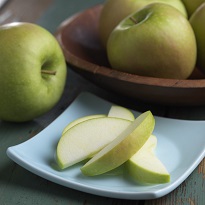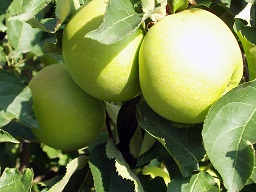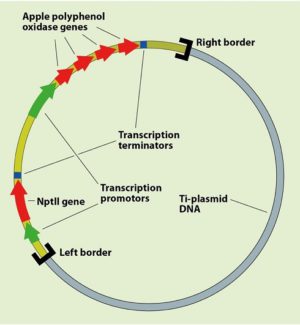In cisgenesis, we insert new DNA in a stable form into plant DNA, just like in transgenesis. The difference being that in transgenesis, the new DNA originates from another species, in cisgenesis from a plant with which the acceptor plant can crossbreed. Researchers from Plant Research International at Wageningen UR have been arguing for almost fifteen years now to exempt cisgenic plants from GMO rules and laws. This would greatly facilitate and speed up their commercialization.
Hans Tramper is professor emeritus in Bioprocess Technology at Wageningen University and reflects on the development of his subject in a series of essays. His pieces were published so far on 18 June, 30 June, 11 July, 22 July, 19 August , 10 September, 21 September, 30 September, 10 October, 31 October, 8 November, 2 December and 26 December 2018, and 21 April 2019.
Cisgenesis: does it produce genetically modified organisms (GMOs) or not?
In 2005, plant breeders from Wageningen UR propose to the Dutch parliament to exempt cisgenic plants from GMO legislation. In 2006, they publish their arguments in EMBO reports and Nature Biotechnology. In 2013, the Dutch government asks the European Commission not to classify cisgenic plants as GMOs, as they are as safe as classically crossbred plants, and can contribute to sustainable food production. As a matter of fact, they are completely similar to the same crops arrived at by classical crossbreeding, a much more cumbersome and time-consuming process. In Canada, regulation is based on the product and for that reason, they are not classified as GMOs. But they are in Europe, as regulation there is based on the production pathway. Unfortunately, this will not change at a short notice, see the ruling of the European Court of Justice, July 25, 2018. In the US and Canada, the first ‘cisgenic’ product is commercially available, Arctic apples.

Artic apples
Conforming myself to the new Dutch guidelines for a healthy diet, I prepare a lot of fruit each morning for our breakfast. These guidelines indicate an amount of 250 grams p.p. of fruit. Mostly we include a peeled apple in this early vitamin bomb, although I am allergic for certain apple varieties – obviously, I do not choose those. In order to prevent them from browning, I have half a lemon at hand. I coat the freshly peeled apple slices with lemon juice and these keep its fresh appearance. That will do the trick, is my thought. But Neal Carter, founder and CEO of the Canadian company Okanagan Specialty Fruits (OSF), has quite another opinion on that. The company has genetically modified several apple varieties in such a way that they keep their fresh appearance after peeling even without treatment with lemon juice. Carter coined the name Arctic apples for them and now sells them, telling us that less of the peeled slices need to be thrown away. They posted a cute and informative video on OSF’s website that shows it all in a nutshell. ‘We introduce apple genes to turn off PPO-genes that are already present in the apple,’ we are told. On the basis of that information I concluded in my column Apples from the North pole (in Dutch) posted June 13, 2016: ‘As there is no question of extra genes foreign to the apple species, they hope and even expect that consumers will accept these cisgenic apples readily, contrary to transgenic products that do contain foreign genes. The Arctic apples are produced by cisgenesis rather than transgenesis – that is the term used for organisms when modified with genes from their own species, for example from wild varieties.’ And I wasn’t the only one who labelled them as cisgenic. Having had a second look, I now conclude that this label cisgenic was premature and will return to that in my final paragraph. Moreover, I haven’t seen using the company this term anywhere.
What causes apple discoloration?
Often, ripe apples are beautiful, colourful fruit. They look tasty and people may be tempted to have a bite, seeing them on the supermarket shelves. If you do so, the ‘wound’ will soon become brown. Also on peeling or if the apple has been damaged, the pulp will discolour in most varieties. The three culprits are polyphenols, oxygen and the enzyme polyphenol oxidase (PPO). If the plant cell is intact, PPO is in another compartment than the polyphenols, but as soon as the plant cells get damaged by biting, peeling or bumping, the two compounds get together and the enzyme oxidizes the polyphenols with airborne oxygen, causing discoloration and loss of taste and structure. Because of this process, some 40% of the apples generally ends up in the bin. In addition to that: polyphenols are antioxidants; upon oxidation they lose that property and the apple loses nutritional value. This is a process that does not happen in Arctic apples. We may therefore presume that these apples are at least as healthy, and will remain so after peeling, but this has not yet been researched.

Polyphenol oxidases (PPOs)
Many other plant species also contain PPOs, for instance potatoes, bananas and avocados, that also discolour quickly if cut. Human beings are diploid, i.e. we have two sets of 23 chromosomes, one of both parents. Many plants have more than two sets of their specific number of chromosomes and are called polyploid. Therefore they often have multiple isoenzymes in the various organs and tissues. Isoenzymes catalyse the same reaction, but they do not have exactly the same amino acid sequence, meaning that the coding genes are not exactly the same. We can identify, isolate and clone four different PPO genes in an apple; each apple variety has a set of its own. OSF has prevented the formation of PPOs in several apple varieties by a process called gene silencing using RNA interference (RNAi).
RNA interference
RNAi is one of the processes called post-transcriptional gene silencing. This is an ancient ubiquitous biological reaction on double-stranded RNA (dsRNA). This mechanism lends resistance to organisms to both endogenic parasites and exogenic pathogenic nucleic acids; it also regulates gene expression. It prevents unwanted gene expression to happen by cutting messenger RNA (mRNA). Among the endogenic RNAi triggers are dsRNA of viral origin or dsRNA originating from foreign DNA, like the apple genes inserted in the OSF gene construct (see below). In his 2001 review RNA interference, Sharp writes that dsRNA derived from a related but non-identical gene can be used to silence the corresponding gene of the organism. According to him, these related genes should consist of at least 90% identical base pairs. Moreover they need to have a consecutive identical segment of considerable length, probably at least 30-35 base pairs. He also writes that long dsRNAs are more active than short ones. According to Craig Bettenhausen (2013), the apple genes inserted by OSF have a length of 300-1800 base pairs and are almost exact copies of the plant’s own PPOs.
RNAi mechanism
If upon transfer of DNA to single-stranded RNA, it is assessed to be ‘different’, it will be ‘folded’ to hairpin-like dsRNA that triggers RNAi. A simplified model of this is based on two steps, each catalysed by a different ribonuclease (RNAse). In the first step, a first ribonuclease will cut dsRNA to short segments of siRNA (short interfering RNA) of 20-25 base pair fragments. In the second step, it will pull apart the strands of this siRNA, and one of them will be uploaded in the so-called RNA-induced silencing complex (RISC). These loaded strands bind all mRNA with a complementary section, i.e. also the own PPO genes in the case of Arctic apples. Then a second RNAse will cut this bound mRNA and in so doing, prevent that mRNA can be read as a recipe for the corresponding protein in the ribosomes. In order to silence all four PPO genes in the apple, we need to insert four closely related different apple genes (or fragments of them). To this end, OSF has produced a gene construct.

OSF gene construct
For production of this gene construct, OSF started with a Ti-plasmid of Agrobacterium tumefaciens (see Essay 4.3). This plasmid can invade entire plants, plant cells and plant tissues; part of it, the so-called T(ransfer)-DNA fragment, will integrate in the plant genome. We can isolate the Ti-plasmid from A. tumefaciens and then open it up with a specific restriction enzyme in the restriction site of the T-DNA. After cutting, we can replace the original genes by another DNA fragment. This can be a DNA fragment that lends another property to the plant, i.e. in the case of Arctic apples silencing PPO formation. In order to achieve this, OSF used standard molecular biologic techniques. The gene construct contains four different apple PPO genes (or fragments thereof), closely related to, but not quite identical to the PPO sets of the apple varieties in which OSF has silenced PPO formation by RNAi. The schematic representation is derived from a figure in the article Engineerd Apples Near Approval by Bettenhausen, quoted above. In addition to these four related apple genes, the T-DNA segment of the OSF gene construct also contains promotors, terminators and a marker gene (see next paragraph).
Market introduction
OSF originates from Canada, a country with product-based regulation of GMOs. If the Arctic apple would be produced by cisgenesis, any additional DNA would be apple DNA. This implies that this new apple could have been produced by classical breeding techniques like cross-breeding, although with a lot more effort and costs. It would also imply a much simpler approval process in Canada in the area of food and environmental security. However, the promotor of the inserted apple genes (see figure) has been derived from the cauliflower mosaic virus. In addition to that, the nopaline synthase terminators and the nptII marker gene are foreign to apples. The implication is that Arctic apples are definitively non-cisgenic, contrary to my original judgement. And that the regular GMO regulations apply to Arctic apples, even in Canada.
The nptII marker gene lends tolerance to the plant for the antibiotic kanamycin. NptII isn’t just the name of the gene but also of the protein for which it carries the code. That protein renders kanamycin tolerance to the plant. Already in 1993, nptII was granted GRAS status by the American FDA, meaning that it can be used in food without specific FDA approval. The fragments of apple tissue treated with the OSF gene construct were exposed to kanamycin, and just those fragments that had successfully incorporated the T-DNA, stayed alive. Out of 2000 that just held for ten, according to OSF CEO Neal Carter, and in just one single fragment PPO formation was suppressed sufficiently. All in all, according to him it takes some ten years to produce an Arctic variant of a common apple, and get it through the approval process and on the market, not unusual for transgenic varieties.
GMOs, no cisgenesis
OSF plants its first test apple in 2003. After nine years of testing, OSF files a request in 2012 at APHIS (Animal and Plant Health Inspection Service) of the USDA (United States Department of Agriculture), to have approved two Arctic apples, a Golden Delicious and a Granny Smith. In 2015 this American agricultural department rules that health and environmental risks are negligible. They judge the risk of unforeseen escape into the environment to be nil, and the trees not to be more susceptible to diseases and plagues than others. It is one of the first genetically modified fruit trees of which the fruit has been allowed for consumption. It was only preceded by transgenic papaya trees in Hawaii.
And now, Arctic apples have hit the American and Canadian markets, in the form of prepacked slices, fresh and dried, the latter on sale at Amazon. I see some social value in the fresh slices, from an educational point of view. If one provides school children with an apple in their lunchboxes, most of them end up in the bin half-eaten. A package of fresh-looking slices as a snack between meals can contribute to more regularly savouring fruit.
As for myself – I am particularly allergic to the Granny Smith – I will have to wait for the apple without any allergens, for I actually like this hard apple with its fresh taste. Great to have a bite, with its skin. But in the Netherlands I don’t foresee the arrival of the Arctic apple for quite some time. Even the plant researchers from Wageningen UR, who have developed by cisgenesis an apple resistant to scabies and moreover a cisgenic potato resistant to phytophthora, have lost their faith in the future as far the EU is concerned. They have now vested their hope in Canada and the US, where such products get a fair chance. I am confident that the trust radiated by OSF’s CEO Neil Carter will some time cross the ocean. And recently, the third Arctic apple has been allowed for human consumption, a Fuji of the same company. And… there is more to come, the next candidate is the Gala.
I am indebted to Dr. Henk Schouten, plant breeder at Wageningen UR. He helped me when I got stuck, and provided encouraging comments on my last draft. I was happy to put them to good use.
